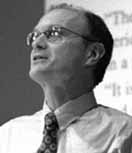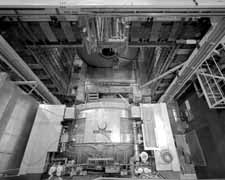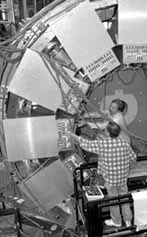 |
|
State of the Lab by Mike Perricone Exciting Science, World's Best Experiments, and lots of Construction
When Director Michael Witherell began his presentation on the state of Fermilab at the close of 1999, he made sure the assembly of all hands knew this was not a summons to the principal's office. "This meeting was not called to make an announcement," Witherell told the Ramsey Auditorium gathering, "and there is no crisis." The last formal all-hands meetings in December 1998 were called for security briefings mandated by the Department of Energy. But in this series of four meetings from December 13 to December 16, 1999, Witherell set a new direction for business as usual: a direction emphasizing communication within the Laboratory, a direction set from the top and also suggested strongly by the results of an employee opinion survey giving Lab management low grades in communication (see "Survey Says...,"). "I often talk about Fermilab to outside groups, to people who fund us and review our work, and I thought it would be good to talk about these same things with our staff," said Witherell, who became the Lab's fourth director on July 1, 1999. "While I was going to make this presentation in any event, [the survey] added to the incentive for this discussion." The survey also produced notably strong responses regarding pride in the Laboratory, and job satisfaction, concomitant with top levels of scientific achievement. "The research done here is exciting science," Witherell said, "and it competes well with that done in any field, anywhere in the world. Fermilab people and facilities represent an incalculably valuable asset to U.S. science. Thousands of physicists in the U.S. and abroad depend on the Lab to do their research. The Fermilab program is addressing the most important issues in our field, with experiments that are among the best in the world." But communication is only self-congratulation if it sidesteps challenges, and Witherell did no sidestepping. The Director openly discussed the challenges facing the Lab in gearing up for Collider Run II of the Tevatron in 2001. Run II, the Lab's highest priority, will be conducted in the shadow of the Large Hadron Collider in Europe, which is expected to be completed and operating within the next six years. Unsurprisingly, the need for funding lies at the root of the Lab's biggest challenge, in balancing the needs of: two construction projects for Run II preparations; two construction projects for the LHC; two construction projects for neutrino research; participation in the non-accelerator construction project in Argentina for the Pierre Auger Observatory, the astrophysics experiment investigating high energy cosmic rays; researching the next generation of particle accelerators beyond the LHC.
"Although all are given high priority by the high energy physics community, we're under pressure to get these going as soon as possible," Witherell said. "Our funding does not match the total need, and that's the most difficult problem we face." Under the charge of the Lab's Physics Advisory Committee, Run II holds the highest priority. Witherell said the Lab's strategy would focus on completing the Run II detector upgrade projects as quickly as possible, meaning some projects bearing on the Lab's long-term future might be delayed or postponed. He stressed that the Lab will suffer no long-term harm from this year's budget pinch. Run II holds the potential for discoveries at the energy frontier that will change the direction of the field in the next six years, discoveries in the realm of the Higgs field and the postulated source of all particle mass. Witherell underscored that potential with an eye-opening statistic: with present and future upgrades, the Tevatron will ultimately deliver 100 times the luminosity, or number of particle collisions, that produced the discovery of the top quark in 1995. Looking through the lens another way, the Tevatron has so far delivered up only one percent of the collisions it can produce. "The Tevatron will have a long period of running without interruption from the fixed-target program, and it should be the best period in the collider's history," the director predicted.
The collider detectors are now slated to roll into the collision halls in March 2001. They will join the accelerator complex that drives the Lab's research, and it's an accelerator complex that has not been simply marking time. In addition to completing the $260 million Main Injector-Antiproton Recycler project in 1999, the Lab has also performed significant upgrades on both the Tevatron, the world's highest-energy particle accelerator; and the Antiproton Source, key to increased luminosity in Collider Run II. "We really have quite a new accelerator complex," Witherell emphasized. "Our main mission for the coming year is getting this very complicated set of accelerators working together, with high luminosity for the collider mode. That comprises most of the what the Lab will be doing."
"All 2,100 people at this Lab have integrated safety as part of their job," he said. "That's important in the way we work. But we also need a good safety record to clear away that issue, so we can concentrate on getting the research done." As the largest U.S. high energy physics facility, and one of five large high energy physics facilities around the world (Europe's CERN being the largest), the Lab has a broadly-based research program: Accelerator-based experiments, including a Main Injector fixed-target program, will investigate Higgs mysteries and supersymmetry possibilities, and further the knowledge of CP violation marking behavioral differences between particles and antiparticles. Probing the intriguing question of neutrino mass, the Main Injector Oscillation Search (MINOS) and the on-site MiniBooNE (Booster neutrino) experiment are the keys in what Witherell described as "building the world's best neutrino program over the next two years." An additional detector will eventually join the MINOS detector site in Soudan, Minnesota, as part of the Cold Dark Matter Search. Astrophysics projects will search for the source of high-energy cosmic rays (Pierre Auger), and map the sky in an unprecedented scope (Sloan Digital Sky Survey). Further, the Lab's production facilities are providing accelerator and detector components for the LHC, and the Lab will also serve as the U.S. host for an experiment at CERN that Witherell said will occupy "a central place in U.S. particle physics programs." And whatever lies beyond LHC, whether the next-generation machine emerges as the Next Linear Collider, the Very Large Hadron Collider, or some combination of muon collider/storage ring/neutrino source, Witherell asserted Fermilab's leadership position. "Our goal is to build the next collider on the energy frontier here at Fermilab," he declared. "Unlike 15 years ago in this country, there is not yet a clear consensus in the field on what that facility will be. So we must play a leading role in research and development on accelerators for the future, to direct that future within the field." The director left no doubt about the source for success. "This Lab has a great past, a great present, and --I hope I've convinced you--a great future," Witherell concluded. "The primary resource we have in facing that future is the talent, the industry and the good will of the people at Fermilab." |
| last modified 1/14/2000 email Fermilab |
FRLsDFx9eyfrPXgV

 But first, the Run II construction needs to be completed. The 5,000-ton CDF and DZero detectors have had their electronics stripped out and are being rebuilt. Witherell pointed out that at $80 million each, including equipment plus operating funds, those upgrade projects are actually bigger than building most experiments in high-energy physics.
But first, the Run II construction needs to be completed. The 5,000-ton CDF and DZero detectors have had their electronics stripped out and are being rebuilt. Witherell pointed out that at $80 million each, including equipment plus operating funds, those upgrade projects are actually bigger than building most experiments in high-energy physics.
 With the high levels of activity, the Lab's safety record becomes all the more impressive. Witherell noted that over the last two years, the Lab has cut its "Lost Work Day Case Rate" by a factor of two.
With the high levels of activity, the Lab's safety record becomes all the more impressive. Witherell noted that over the last two years, the Lab has cut its "Lost Work Day Case Rate" by a factor of two.